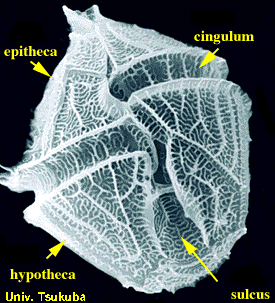dinoflagellate

Dinoflagellate labelled.
A dinoflagellate is any member of a class of unicellular algae characterized by having two whip-like flagella. About half the species of dinoflagellate contain chlorophyll and are photosynthetic; the other half are predators that attack bacteria, algae, and even fish. Ninety percent of dinoflagellate species dwell in the ocean.
Some species of dinoflagellate glow in the dark by a process called bioluminescence. These contain a compound called luciferin (the same compound found in fireflies). The glow increases markedly if the algae cells are agitated, as when a ship churns through the water.
Dinoflagellate neurotoxins can concentrate in the bodies of shellfish and fish that eat the algal cells, in turn causing people who eat these seafoods to come down with illnesses such as paralytic shellfish poisoning and ciguatera (a combination of gastrointestinal, neurological, and cardiovascular disorders.)
So-called red tides occur when enormous blooms of trillions of dinoflagellates are triggered by an upwelling of nutrients from the water's depths during warmer seasons. The population of dinoflagellates can jump to more than 20 million cells per liter of sea water along some coasts during these blooms, turning the water a reddish hue.
Anatomy
The flagella of a dinoflagellate are inserted into the cell wall via the flagellar pore(s) at approximately the same location. In most dinoflagellates one of the flagella wraps around the cell and is known as the transverse flagellum; the other, called the longitudinal flagellum, extends tangentially to the cell, perpendicular to the plane of the transverse flagellum. The beating of the longitudinal flagellum and the transverse flagellum imparts a forward and spiralling swimming motion, and defines anterior (the direction of swimming) and posterior (opposite to anterior and the direction the longitudinal flagellum is directed). The flagellar pore and point of flagellar insertion defines ventral with the opposite side dorsal. Left and right sides of the cell are then defined as in most organisms. A depression often occurs on the ventral surface at the point of flagellar insertion, and is known as the sulcus. The transverse flagellum often occurs in a furrow known as the cingulum which encircles the cell except where interrupted by the sulcus on the ventral surface.
The cell wall of dinoflagellates is subdivided into multiple polygonal amphiesmal vesicles of varying numbers (from half a dozen to hundreds). In some dinoflagellates, these vesicles are filled with relatively thick cellulose plates with bounding sutures. When this occurs, the cell wall is referred to as a theca. Dinoflagellates possessing a theca are often referred to as "armored dinoflagellates", while those without are referred to as "naked dinoflagellates".


